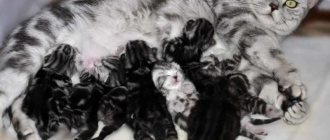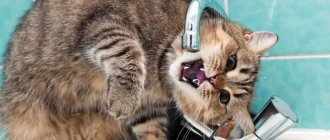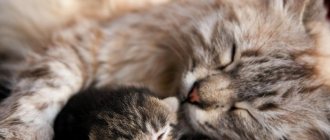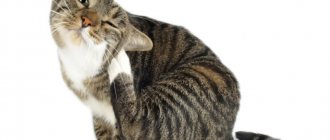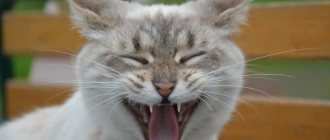Breathing is life. This is one of the reasons why cats and dogs with respiratory failure require quick and effective treatment. Experts at the Berloga veterinary clinic talk about what pulmonary failure is in animals, what symptoms it is accompanied by, and how therapy occurs.
Read in this article:
What is this?
Causes of pulmonary failure
How does DN manifest itself in cats and dogs?
When to ask for help?
How is respiratory failure treated in dogs and cats?
Initial stabilization
Diagnostics
Therapy
Causes of shortness of breath in a cat
The development of pathology is caused:
- Diseases leading to insufficient blood flow to the lungs and impaired oxygenation: diseases of the heart, pulmonary arteries, lower respiratory tract (pneumonia, bronchitis), metabolic disorders.
- Compression of the airways, which interferes with the normal passage of air: tumors of the lungs and mediastinum, trauma, obstruction (edema, foreign bodies), underdevelopment (hypoplasia) of the larynx, trachea, bronchi, proliferation of the thyroid gland, thoracic lymph nodes, helminth infestations.
- Accumulation of pathological agents in the pleural cavity or lung tissue: hemothorax (hemorrhage), pneumothorax (air retention between the layers of the pleura), hydro-, chylo-, pyothorax (exudation of pus), pulmonary edema.
- The accumulation of fluid in the abdominal cavity (ascites), which reduces the space for the diaphragm to descend, resulting in a decrease in inhalation volume and faster exhalation.
- Neurological pathologies. Most often associated with damage to the respiratory center of the brain, which results in disruption of the regulation of inhalation and exhalation.
- Systemic fungal diseases (mycoses).
- Anemia of various origins. A deficiency or abnormal form of red blood cells results in the inability to transport sufficient oxygen.
- Induction with medications (hypnotics, steroids).
- Pulmonary embolism. Acute ischemia leads to cessation of gas exchange in the lung area.
- Uremia (occurs mainly in chronic renal failure).
- Bronchial asthma.
Shortness of breath in a cat often indicates a serious condition and the need for an urgent visit to a veterinarian.
What is this?
Respiratory failure (RF) in dogs and cats is a pathological condition in which the animal’s lungs do not provide normal blood gas composition or do, but it is achieved due to the intensive work of the external respiratory apparatus and heart, which reduces the functional characteristics of the body.
Important! Pulmonary insufficiency in cats and dogs is dangerous because without timely treatment it leads to acute and chronic diseases of the bronchopulmonary system, circulatory disorders, damage to the central nervous system and a number of other dangerous complications.
Shortness of breath in cats after playing
Owners are often concerned about the appearance of breathing problems in their animals after significant physical exertion. This reaction is normal, because with increased activity the body needs a large amount of oxygen.
Shortness of breath in cats after playing with light exertion may be evidence of obesity. If physical activity causes breathing problems, the animal should be examined and the daily diet should be reviewed according to the recommendations of the veterinarian.
Signs of danger
The combination of this condition in an animal with an increased need to drink water requires urgent medical intervention.
The following signs indicate an urgent visit to the veterinarian:
- temperature increase;
- body position when the cat lies on its stomach, legs spread out and neck stretched out;
- confusion or loss of consciousness;
- impaired coordination of movements;
- increased thirst;
- lethargy, refusal to play;
- wheezing and whistling during inhalation or exhalation;
- cyanosis or pallor of mucous membranes;
- violation of the frequency of respiratory movements.
Symptoms of shortness of breath in cats
With the development of acute pathology, external symptoms appear within several hours. The chronic course of the underlying disease causes shortness of breath as the hemodynamic, gas exchange and perfusion characteristics of the lungs change.
Changes usually begin with an increase in breathing rate (over 35 breaths per minute). A characteristic symptom of cats is “dog breathing,” when the animal breathes with its mouth open. Excitement occurs, contractions of the abdominal muscles to assist the act of breathing, and panic increases over time.
If the cause of the pathological condition is fluid accumulation or bronchial asthma, wheezing becomes audible, sometimes at a distance (remote). The cyanotic color of the visible mucous membranes and skin quickly increases, and certain areas of the oral cavity turn pale.
Shortness of breath, breathing with an open mouth or wheezing in a cat
Orlova Maria Eduardovna anesthesiologist-resuscitator
Signs of a breathing disorder
:
- unusual sounds (wheezing)
- unusual posture, restlessness, inability to lie down
- pale or bluish discoloration of the gums and lips
- very rapid breathing or difficulty breathing, with visible effort when inhaling or exhaling.
- for cats: open mouth breathing
You could even say that if a cat breathes with its mouth open, it has serious problems.
.
The exception is fat cats who can afford to breathe with their mouths open after long games. Although, of course, an overly fat cat cannot be called completely healthy.
The body of land animals does not know how to create oxygen reserves
, so if any serious breathing problems occur, the lack of oxygen can very quickly become life-threatening. Therefore, if the animal has any breathing problems, you should not postpone a visit to the doctor. If the animal’s condition worsens, shortness of breath intensifies, lips and gums become bluish or purple - emergency assistance is required, minutes can count.
How to help at home
? The cat needs to be kept calm and not create additional stress on the respiratory system (it is vitally important not to agitate the cat, this can be very dangerous!). Under no circumstances should you try to put the cat down or give it water - this can be dangerous. There is no need to use any drugs that stimulate breathing - in most cases this is not only pointless, but can also be harmful. It is necessary to take the animal to the doctor as quickly and carefully as possible.
What will the doctor do?
? When providing first aid to a patient with difficulty breathing, the main task is to provide the body with oxygen. Sometimes it is enough to place the animal in an oxygen chamber or allow it to breathe oxygen using a mask, sometimes urgent surgery or artificial ventilation is required. Simultaneously with providing first aid, the doctor will conduct diagnostics, and his further actions will depend on what cause of breathing problems he discovers.
If the airway is obstructed
– air does not reach the lungs or is supplied in insufficient quantities. An obstacle to the passage of air may be a foreign object in the upper respiratory tract (a piece of food or plant), trauma to the upper respiratory tract (for example, a bite), or swelling of the tissues of the neck. To help a patient with obstruction of the upper respiratory tract, it is necessary to quickly ensure its patency - remove the foreign body, relieve swelling with anti-inflammatory drugs. In an emergency, tracheal intubation may be required (the doctor will insert a tube into the trachea through the mouth), or installation of a tracheostomy (in this case, the tube will be inserted into the trachea from the surface of the neck, below the “blocked” area). These procedures are performed under general anesthesia.
If the lungs are affected
, gas exchange is disrupted, and the blood is not saturated with oxygen. The causes of lung problems can be bruise due to injury, pneumonia (pneumonia), or pulmonary edema. In cats, shortness of breath may develop due to long-standing, untreated feline asthma. Such patients typically have rapid breathing that requires great effort.
It is also important to remember that cats can also suffer from heart disease.
. These diseases are typical for British cats and Sphynx cats. In this case, the initial problem is not in the lungs, but in the fact that the heart is not able to adequately pump blood through the vessels, because of this, stagnation of blood develops in the vessels of the lungs, and fluid leaks into the lung tissue. All patients with lung pathology usually require hospitalization, intensive treatment, sometimes for several days, and in severe cases, artificial ventilation.
Difficulty breathing may be caused by problems in the chest area
, such as severe rib fractures, fluid or air accumulation in the chest cavity. To help such a patient, the cause of the disease must be quickly eliminated. For example, a cat that has fallen from a great height often has free air in the chest cavity. It penetrates the chest cavity from the injured lungs and compresses them, making it difficult to breathe. In such a situation, the doctor must remove air from the chest cavity through a puncture of the chest wall. Sometimes it is necessary to install a drainage - a special tube through which accumulated air can be removed. As a rule, such patients also need to be monitored in a hospital.
Of course, what we have described is only a small part of the large number of reasons that cause breathing problems in our pets. It is important to remember that cats are animals with a very vulnerable respiratory system.
.
It can be quite rightly said that the lungs of cats are their weak point; the safety margin of the respiratory system of cats is very small. Therefore, any breathing problems in cats should be taken very seriously
. There is not a single disease that causes shortness of breath that can be treated at home. Be careful!
Orlova Maria Eduardovna anesthesiologist-resuscitator Source: veterinary clinic Bely Klyk
Diagnosis of shortness of breath in cats
Not only anamnesis and a general physical examination, but also an in-depth examination, including:
- Careful auscultation to detect changes in the functioning of the heart and lungs.
- Tonometry.
- X-ray of the chest, neck, abdomen.
- Cardiological examination with ECG and EchoCG according to indications.
- Laboratory blood test.
- When performing a puncture, pathological fluid from the pleural cavity is also transferred to the laboratory.
- Severe cases requiring in-depth differential diagnosis are an indication for bronchoscopy and esophagoscopy.
It is important to remember that shortness of breath in cats is not an independent disease, but a symptom indicating the progression of the underlying disease or the development of complications. Therefore, a thorough diagnosis will help to begin timely, effective therapy.
Causes of pulmonary failure
Any disturbance in the functioning of one or more respiratory organs (for example, the respiratory tract or lungs) can lead to the development of respiratory failure in a cat or dog, which poses a direct threat to the health and life of the animal.
Respiratory failure occurs when the level of oxygen in the blood becomes too low (hypoxemic form) and when the level of carbon dioxide in the blood becomes too high (hypercapnic form).
Important! The causes of hypoxemic (pulmonary) and hypercapnic (ventilatory) forms of respiratory failure in dogs and cats differ.
Causes of hypercapnic (ventilation) form of respiratory failure:
- Violation of central regulation of breathing (control of respiratory muscles). Such disorders occur with arterial hypotension (low blood pressure), as well as with pathological processes occurring in the central nervous system (for example, meningoencephalitis), traumatic brain injury and poisoning with drugs that suppress the functioning of the respiratory center.
- Neuromuscular disorders. The main feature of such diseases is muscle weakness. Respiratory failure in cats and dogs can occur against the background of myopathy (chronic progressive neuromuscular diseases), as well as ruptures or unilateral persistent high position of the diaphragm, accompanied by damage to the phrenic nerve in animals.
- Damage to the chest and pleural cavity. The causes of respiratory failure in dogs and cats can be pneumothorax (accumulation of air or gases in the pleural cavity), floating rib fractures, neoplasms (malignant and benign tumors), as well as foreign objects trapped in the chest, and even metastatic pleurisy (inflammation of the pleura) .
- Airway obstruction. Respiratory failure in dogs and cats can be caused by bronchial asthma, laryngeal edema, as well as narrowing of the lumen of small bronchi and bronchioles (bronchospasm). These diseases impair the animal's airways, which can lead to the development of respiratory failure.
Causes of hypoxemic (pulmonary) respiratory failure, when the oxygen level in an animal's blood becomes too low, include pneumonia, acute respiratory distress syndrome, pulmonary edema, as well as lung injury in cats and dogs, pulmonary fibrosis, and pulmonary thromboembolism.
Treatment of shortness of breath
Therapeutic measures depend on the cause that caused shortness of breath. Increasing respiratory failure requires urgent initiation of therapy before an accurate diagnosis is made in order to stabilize the patient's condition. The animal is placed in an oxygen chamber to improve oxygenation. According to indications, thoracentesis is performed (removal of fluid or air accumulation from the pleural cavity).
Drugs are prescribed to relieve swelling and remove excess fluid from the body. Cardiac glycosides and bronchodilators are administered. If the cause of shortness of breath is a bacterial infection, then broad-spectrum antibiotics are used.
If the measures taken do not eliminate respiratory failure, tracheal intubation with further connection to a ventilator is indicated.
When the cat returns home, you need to carefully follow the veterinarian’s recommendations, avoid stress, and control appetite and activity. This will help prevent relapses of the disease, and will also increase the quality and life expectancy of the animal.
Diagnostic measures
To identify the reason why a cat has rapid breathing and heartbeat, the veterinarian asks the owner about possible antecedent factors, conducts a visual examination and prescribes diagnostic methods, such as:
Tonometry can help identify the cause of this symptom in a fluffy.
- X-ray of the sternum;
- electro- or echocardiogram;
- listening to the heart and lungs with a phonendoscope;
- pressure measurement;
- general blood analysis;
- bronchoscopy;
- stool analysis if helminths are suspected;
- puncture of fluid from the pleural area if necessary.
Physiological reasons
Shortness of breath signals a lack of oxygen to the animal's brain. Even if the causes of this phenomenon are physiological, the symptom itself is not harmless. In this case, it is classified as physiologically acceptable. When it appears, the animal needs a little help and the supply of oxygen to the brain will be restored.
Response to physical activity
During active physical activity, the animal’s body burns oxygen more actively, so the cat is forced to oversaturate it with this element. But if shortness of breath appears after a short game, you should pay attention to the pet’s build. Perhaps he is obese and has breathing problems just a signal of this.
Reaction to stress
In stressful situations, large doses of adrenaline are released into the cat’s blood. This hormone causes your heart rate to increase and your lungs to hyperventilate. A large number of emotions can lead to the production of adrenaline: fear or anger, rage or anxiety.
Injury
Bruises in the rib area and sharp pain during breathing movements can lead to the animal breathing frequently and shallowly.
Hyperthermia
If an animal sleeps near a radiator or in the sun, it can actively breathe through its mouth. Cats do not have sweat glands like those in humans. Therefore, fast and frequent breathing is the most effective way for them to cool down. If the cat begins to pant heavily, it needs to be moved to a cooler place. If shortness of breath does not stop, you need to measure your body temperature.
Treatment
It is not the shortness of breath itself that needs to be treated, but the cause that caused it. If the animal overheats, it needs to be moved to a cooler room. Experienced breeders recommend cutting long-haired pets for the summer.
If the animal reacts violently to not too serious stimuli, for example, it is afraid of trips to the clinic, you can ask the veterinarian to recommend sedatives (Cat Bayun or VetSpokoin).
If your pet is too well-fed, gets tired quickly and breathes heavily, it’s time to think about a proper diet for him. There are special dietary foods for this, which your veterinarian will help you choose.
If the shortness of breath is caused by something more serious, then special treatment, drug or surgical, will be needed.
Causes
Below we will discuss the top seven reasons why your cat is panting. Some causes do not require medical attention, but for more serious causes of wheezing, you should immediately consult a veterinarian you trust.
© shutterstock
- Excessive play time in extreme heat . One common reason your cat is panting is due to overheating. This may occur due to excessive play or exercise in hot climates. If your furry friend is panting as a result, stop your cat from any further activity and help her relax and cool down.
- Your cat is experiencing sudden stress . If there is a sudden change in your home, such as a new guest, a new pet, or a new building, your cat may become nervous and panting.
- Asthma . It may come as a shock to you, but cats are just as prone to asthma as humans. With this condition, your cat may develop allergies to environmental particles, which causes a narrowing of the air passages in the lungs.
- Respiratory tract infection . Your four-legged friend's respiratory tract may be infected with a virus, bacteria, fungus, or any other pathogen. This infection can lead to inflammation of the respiratory tract.
- Anxiety . An anxious cat will often pant and exhibit several other signs, such as strange behavior, excessive grooming, frequent urination, and changes in diet.
- Heart disease . Your cat can contract this disease from the bite of an infected mosquito. Signs include cough, shortness of breath and difficulty breathing. Talk to your veterinarian about measures to prevent this disease.
- Chronic heart failure . This is a serious disease that causes thickening of the heart muscles. This causes the heart to beat much faster, causing cats to pant. Your veterinarian will put your furry friend on oxygen therapy if a heart attack occurs.
Associated symptoms
When a cat is brought to the doctor, first of all he asks about the signs that alerted the owner of the animal. Therefore, monitoring a presumably sick pet before visiting the clinic is very important. This helps to quickly make a diagnosis.
Signs that accompany the development of pathology of the respiratory system are:
- poor appetite;
- wheezing when breathing;
- increased heart rate;
- elevated temperature;
- rapid pulse;
- redness or bluish tint of the mucous membranes;
- vomit;
- swelling;
- diarrhea;
- the appearance of mucous discharge from the mouth or nasal openings.
The effectiveness of treatment for your pet depends on the amount of time that has passed since the onset of alarming symptoms. There are diseases that develop very quickly. For example, pulmonary edema. Delay in such cases can cost the pet’s life.
Types of shortness of breath
Conventionally, shortness of breath is divided into physiological and pathological. The first occurs in a cat as a reaction to stress or overheating, as well as after injury. The second accompanies diseases of the internal organs.
In addition, it is customary to classify shortness of breath:
- Depending on the change in the frequency of respiratory movements into bradypnea (sparse and shallow breathing) and tachypnea (shallow, rapid breathing). The first develops due to damage to the brain structures and membranes of the brain, perhaps with ascites and endocrine diseases (diabetes). The latter is called “the breath of a hunted animal” and develops with anemia, heat and severe stress.
- Depending on which part of the respiratory movement is difficult, inspiratory and expiratory shortness of breath are distinguished. In the first case, breathing occurs with difficulty inhaling (in case of trauma to the trachea by a tumor or some object). In the second case, the animal has difficulty exhaling. This happens with bronchial asthma. There may also be a mixed form of pathology. Mixed forms can develop after a car injury or a fall from a great height.
Shortness of breath is a symptom of a large number of pathological conditions. Sometimes very serious, for example, cerebral dyspnea, which develops when a tumor or hematoma puts pressure on the respiratory center in the pet’s brain.




